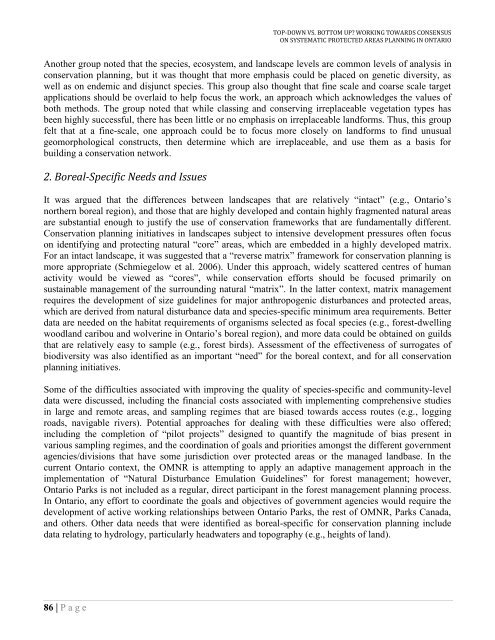Top-Down vs. Bottom Up: Working Towards Consensus ... - CASIOPA
Top-Down vs. Bottom Up: Working Towards Consensus ... - CASIOPA
Top-Down vs. Bottom Up: Working Towards Consensus ... - CASIOPA
- No tags were found...
You also want an ePaper? Increase the reach of your titles
YUMPU automatically turns print PDFs into web optimized ePapers that Google loves.
TOP-DOWN VS. BOTTOM UP? WORKING TOWARDS CONSENSUSON SYSTEMATIC PROTECTED AREAS PLANNING IN ONTARIOAnother group noted that the species, ecosystem, and landscape levels are common levels of analysis inconservation planning, but it was thought that more emphasis could be placed on genetic diversity, aswell as on endemic and disjunct species. This group also thought that fine scale and coarse scale targetapplications should be overlaid to help focus the work, an approach which acknowledges the values ofboth methods. The group noted that while classing and conserving irreplaceable vegetation types hasbeen highly successful, there has been little or no emphasis on irreplaceable landforms. Thus, this groupfelt that at a fine-scale, one approach could be to focus more closely on landforms to find unusualgeomorphological constructs, then determine which are irreplaceable, and use them as a basis forbuilding a conservation network.2. Boreal-Specific Needs and IssuesIt was argued that the differences between landscapes that are relatively “intact” (e.g., Ontario‟snorthern boreal region), and those that are highly developed and contain highly fragmented natural areasare substantial enough to justify the use of conservation frameworks that are fundamentally different.Conservation planning initiatives in landscapes subject to intensive development pressures often focuson identifying and protecting natural “core” areas, which are embedded in a highly developed matrix.For an intact landscape, it was suggested that a “reverse matrix” framework for conservation planning ismore appropriate (Schmiegelow et al. 2006). Under this approach, widely scattered centres of humanactivity would be viewed as “cores”, while conservation efforts should be focused primarily onsustainable management of the surrounding natural “matrix”. In the latter context, matrix managementrequires the development of size guidelines for major anthropogenic disturbances and protected areas,which are derived from natural disturbance data and species-specific minimum area requirements. Betterdata are needed on the habitat requirements of organisms selected as focal species (e.g., forest-dwellingwoodland caribou and wolverine in Ontario‟s boreal region), and more data could be obtained on guildsthat are relatively easy to sample (e.g., forest birds). Assessment of the effectiveness of surrogates ofbiodiversity was also identified as an important “need” for the boreal context, and for all conservationplanning initiatives.Some of the difficulties associated with improving the quality of species-specific and community-leveldata were discussed, including the financial costs associated with implementing comprehensive studiesin large and remote areas, and sampling regimes that are biased towards access routes (e.g., loggingroads, navigable rivers). Potential approaches for dealing with these difficulties were also offered;including the completion of “pilot projects” designed to quantify the magnitude of bias present invarious sampling regimes, and the coordination of goals and priorities amongst the different governmentagencies/divisions that have some jurisdiction over protected areas or the managed landbase. In thecurrent Ontario context, the OMNR is attempting to apply an adaptive management approach in theimplementation of “Natural Disturbance Emulation Guidelines” for forest management; however,Ontario Parks is not included as a regular, direct participant in the forest management planning process.In Ontario, any effort to coordinate the goals and objectives of government agencies would require thedevelopment of active working relationships between Ontario Parks, the rest of OMNR, Parks Canada,and others. Other data needs that were identified as boreal-specific for conservation planning includedata relating to hydrology, particularly headwaters and topography (e.g., heights of land).86 | P a g e


